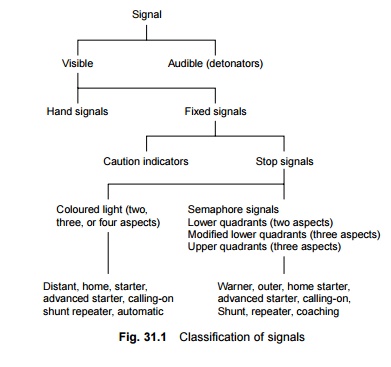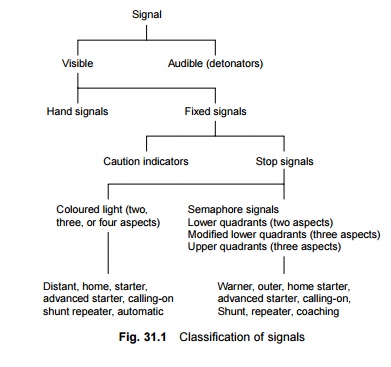Chapter: Civil : Railway Airport Harbour Engineering : Railway Engineering : Signalling and Interlocking
Classification of Railway Signals

Classification of Signals
Railway signals can be classified
based on different characteristics as presented in Table 31.1.
Table 31.1 Classification of
signals

Figure 31.1 shows the further
classification of audible and visible signals. Table 31.2 lists the minimum
signal requirements of various classes of stations.

Further details regarding the different types of stations are
furnished in Previous Pages.

1 Audible Signals
Audible signals such as
detonators and fog signals are used in cloudy and foggy weather when hand or
fixed signals are not visible. Their sound can immediately attract the
attention of drivers. Detonators contain explosive material and are fixed to
the rail by means of clips. In thick foggy weather, detonators are kept about
90 m ahead of a signal to indicate the presence of the signal to the drivers.
Once the train passes over the detonators thereby causing them to explode, the
driver becomes alert and keeps a lookout for the signal so that he/she can take
the requisite action.
2 Visible Signals
These signals are visible and
draw the attention of the drivers because of their strategic positions.
Hand signals These
signals are in the form of flags (red or green) fixed to wooden handles
that are held by railway personnel assigned this particular duty. If the flags
are not available, signalling may be done using bare arms during the day. In
the night, hand lamps with movable green and red slides are used for signalling
purposes.
Fixed signal These are
firmly fixed on the ground by the side of the track and can be further
subdivided into caution indicators and stop signals.
Caution indicators These are
fixed signals provided for communicating to the driver that the
track ahead is not fit for the running the train at normal speed. These signals
are used when engineering works are underway and are shifted from one place to
another depending upon requirement.
Stop signals These are
fixed signals that normally do not change their position. They inform
the drivers about the condition of the railway line lying ahead.
The stop signals normally used on
railways are semaphore signals, coloured light signals, and other such signals
as explained in subsequent sections.
Related Topics